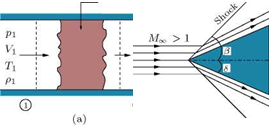Normal Shock Waves
In Section 2.13 of Chapter 2, we briefly discussed about the compression and expansion waves. Now, let us have a closer look at these waves and the flow process across them. Shock is a compression front across which the flow properties jump. Shock may also be described as compression front in a supersonic flow field and the flow process across the front results in an abrupt change in fluid properties. In other words, shock is a thin region where large gradients in temperature, pressure and velocity occur, and where the transport phenomena of momentum and energy are important. The thickness of the shocks is comparable to the mean free path of the gas molecules in the flow field.
9.19.1 Equations of Motion for a Normal Shock Wave
 |
For a quantitative analysis of changes across a normal shock wave, let us consider an adiabatic, constant – area flow through a nonequilibrium region, as shown in Figure 9.23(a). Let sections 1 and 2 be sufficiently away from the non-equilibrium region so that we can define flow properties at these stations, as shown in Figure 9.23(a). Now we can write the equations of motion for the flow considered as follows:
By continuity
P1V1 = P2 V2. (9.133)
The momentum equation is
P1 + P1V2 = p2 + p2V|. (9.134)
The energy equation is
h1 + І V2 = h2 + 2 V2. (9.135)
Equations (9.133)-(9.135) are general – they apply to all gases. Also, there is no restriction on the size or details of the nonequilibrium region as long as the reference sections 1 and 2 are outside of it. The solution of these equations gives the relations that must exist between the flow parameters at these two sections.
Since there are no restrictions on the size or details of the nonequilibrium region, it may be idealized as a vanishingly thin region, as shown in Figure 9.23(b), across which the flow parameters jump. The control sections 1 and 2 may also be brought arbitrarily close to the thin region. Such a compression front across which the flow properties change suddenly is called a shock wave. Heat is neither added to nor taken away from the flow as it traverses the shock wave; hence the flow process across the shock wave is adiabatic.
In many text books shock is defined as a discontinuity. From our discussions above, the question obviously arises; is it possible to have a discontinuity in a continuum flow field of a real fluid? We should realize that the above consideration is only an idealization of the very high gradients of flow properties that actually occur in a shock wave, in the transition from state 1 to state 2. These large gradients produce viscous stress and heat transfer, that is, nonequilibrium conditions inside the shock. The processes taking place inside the shock wave itself are extremely complex, and cannot be studied on the basis of equilibrium thermodynamics. Temperature and velocity gradients inside the shock provide heat conduction and viscous dissipation that render the flow process inside the shock internally irreversible. In most practical applications, primary interest is not generally focused on the internal mechanism of the shock wave, but on the net changes in fluid properties taking place across the wave. However, there are situations where the detailed information about the flow mechanism inside the shock describing its structure is essential for studying practical problems. But since such conditions occur only in flow regimes like rarefied flow fields, it is not of any interest for the present study. Thus, shock is not a discontinuity but an active continuum compression front causing sudden changes to the flow properties.











